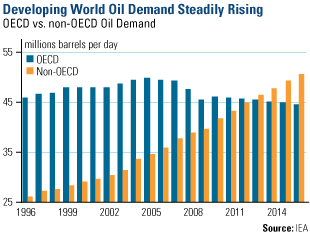Over the last 10 years no theme has dominated the markets like the China story. I’ve consistently harped on the fact that the US economy is no longer the engine of growth in this cycle. Back in early 2009 I wrote:
“For a long time the world economies have played second fiddle to the U.S. You often hear “when the U.S. sneezes the world catches a cold”. But for the first time it looks like we might be catching someone else’s cold. There is little doubt that China was the growth engine of the 2003-2007 bull market. GDP was booming at 11% in China while the U.S. was struggling to maintain 3%+ growth. China’s stock market was up 6 fold during the boom while the U.S. struggled to double. If your company had even a small interest in China it could overcome weakness in any of your domestic segments. The growth was truly remarkable.
…The U.S. might have played an instrumental role in causing many of the issues at hand, but the S&P 500 revenues are now 50% abroad and trust me – the domestic 50% weren’t the ones driving the Dow recovery from 2003-2007. China led us into this recession and it’s likely that China will lead us out. And after a 70%+ decline, China’s not looking like a bad long-term bet to me….”
This is particularly true in the commodity markets where China has been the primary consumer of all things raw materials. It’s a secular trend that has steamrolled you if you got in its way. And this trend hasn’t left the world’s most important commodity untouched. Oil prices have skyrocketed in the last 10 years as from $30 to $98 as demand from China has boomed.
A recent note from US Funds put this demand story into perspective for us:
“The IEA forecasts the world will use 91 million barrels of oil per day in 2012, an increase of 1.5 million barrels per day. The IEA also revised its 2011 oil demand projections upward by 0.2 million barrels per day. Projecting outward to 2016, the IEA’s baseline scenario assumes a healthy 4.5 percent global GDP growth and an average oil price of $103 per barrel. With these assumptions, annual oil demand growth should average 1.2 millions barrels per day through 2016.”
“Emerging markets are almost entirely the source of this increased demand, with China accounting for 41 percent of demand growth over that time period, the IEA forecast says. The chart illustrates how developing (non-OECD) country oil demand has dramatically increased since the mid-1990s while developed world (OECD) demand has decreased. Through two financial bubbles and a global financial crisis, non-OECD demand has stair-stepped its way to nearly doubling in less than 20 years.
How is this possible? Many non-OECD markets have favorable demographics, rapidly urbanizing populations and industrializing economies that have returned many developing economies’ GDP growth rates to pre-crisis levels.
Rising incomes have also outpaced rising oil prices and sustained emerging market demand despite a general reduction in subsidies, the IEA says. Rising wealth has also established a new global middle class that the World Bank estimates will be more than 1 billion strong by 2030. In fact, the World Bank was cited in a National Geographic article earlier this year forecasting that for the first time ever, more people in the world will be classified as middle class than poor in 2022. Today, roughly 70 percent of the world’s population is classified as poor.
Major emerging market countries, such as China, India and Saudi Arabia, have reached the important GDP per capita range ($3,000-$20,000) where oil demand historically “takes-off.”
China carries the biggest stick among emerging markets when it comes to oil demand. Strict tightening measures from Beijing and rising inflation slowed the country’s oil demand growth to its lowest level since 2009 in June. However, China’s oil demand is still expected to grow 7 percent this year, which is inline with the country’s five-year average demand growth rate, according to Deutsche Bank.”
Source: US Funds
Mr. Roche is the Founder and Chief Investment Officer of Discipline Funds.Discipline Funds is a low fee financial advisory firm with a focus on helping people be more disciplined with their finances.
He is also the author of Pragmatic Capitalism: What Every Investor Needs to Understand About Money and Finance, Understanding the Modern Monetary System and Understanding Modern Portfolio Construction.


Comments are closed.